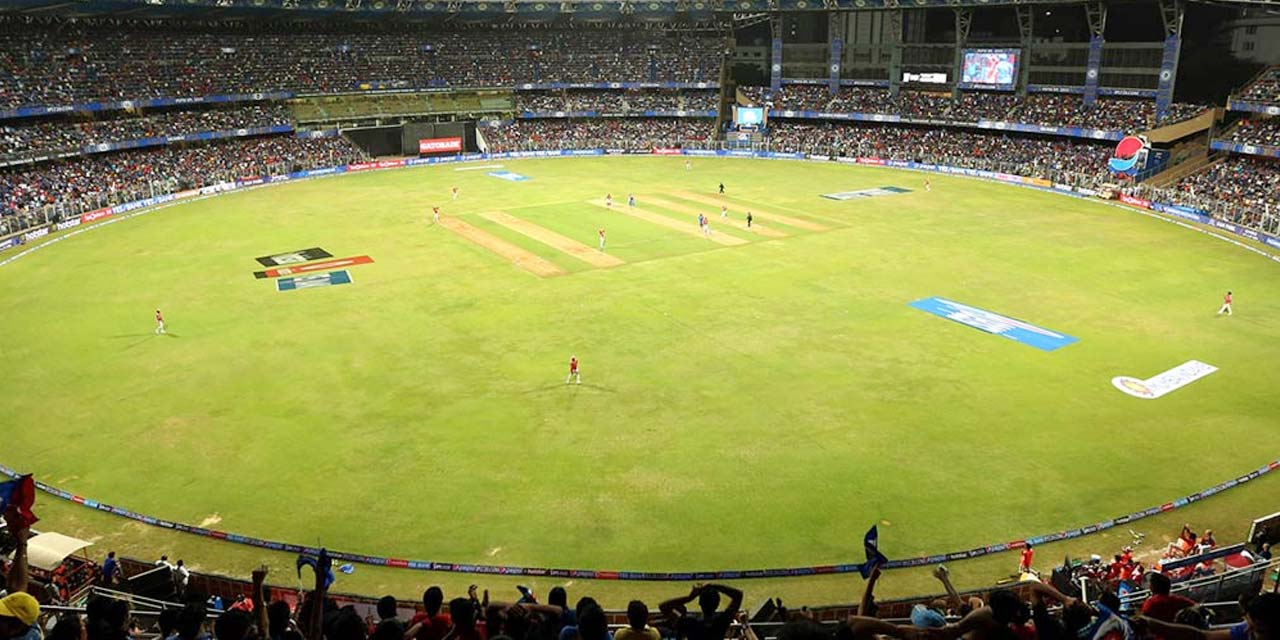
Wankhede Stadium Mumbai Entry Fee
- Tickets price vary based on the match
Wankhede Stadium Mumbai Phone
022 2279 5500
Rating:  | 4/5 stars
| 4/5 stars
Based on total 61 reviews
Wankhede Stadium Mumbai Address: Netaji Subhash Chandra Bose Rd, Churchgate, Mumbai, Maharashtra, 400020, India
Mumbai City Tour Packages
Wankhede Stadium Mumbai Timings
| Day | Timing |
|---|---|
| Monday | 12:00 am – 11:30 pm |
| Tuesday | 12:00 am – 11:30 pm |
| Wednesday | 12:00 am – 11:30 pm |
| Thursday | 12:00 am – 11:30 pm |
| Friday | 12:00 am – 11:30 pm |
| Saturday | 12:00 am – 11:30 pm |
| Sunday | 12:00 am – 11:30 pm |
Mumbai has been famous for buddying cricket enthusiasts and is still considered as the capital city for India’s cricket thereby making Wankhede Stadium the shrine for players. Wankhede Stadium is one of the largest stadiums in India which has been witness to several iconic cricket matches including the 2011 World cup when India brought the cup home for second time after 1983. It was in this year that India became the first team to win a World cup on home ground.
The Wankhede Stadium is also the headquarters of the Board of Control for Cricket in India (BCCI), which is the national governing body for cricket in India. It is home ground for both the Mumbai Indians team of Indian Premier League and the Ranji Trophy Team of Mumbai.
Photography enthusiasts can have a great time exploring various options and angles.
History of Wankhede Stadium Mumbai
Built in 1975, the construction of Wankhede Stadium was commissioned by Seshrao Krishnarao Wankhede, who was a prominent politician and also the secretary of Bombay Cricket Association at that time. It is said that S. K. Wankhede decided to build a separate stadium as a result of rift between the Cricket Club of India and the Bombay Cricket Association. The dispute was over distribution and allocation of tickets of the cricket matches at the Brabourne Stadium that was owned by the Cricket Club of India, which became even more severe after the 1973 test match between India and England.
The most interesting fact about Wankhede Stadium is that the stadium was built in 6 months and was venue for hosting the 1975 final test match between India and West Indies. That match was the first match to be hosted soon after the stadium's inauguration and West Indies won the match. The stadium was named after the man who commissioned it, Barrister S. K. Wankhede, the then President of the Bombay Cricket Association. After this, the Wankhede Stadium became the principal venue for all cricket matches held in the city.
The first match that India won on this home soil was two seasons after the test match of 1975. The match was against New Zealand. After this, many significantly high-profile matches were played here and the stadium also stood witness to some of the greatest performances in the history of cricket. The most noted performances were that of the 1978-79 test series against West Indies when Alvin Kallicharan scored 187 and Sunil Gavaskar scored 205 contributing to India’s victory.
Other memorable performances included Vinod Kambli’s unbeatable score of 224 runs against England during his third test match in 1992-93, which remained the highest score by an Indian at Wankhede Stadium until his record was broken by Virat Kohli in the 2016-17 test against England by scoring 235 runs. The 1979-80 test series between India and England saw the most magnificent innings played by England’s all- rounder, Ian Botham, who scored a century and managed to take 13 wickets thereby contributing to England’s victory in the series.
The first ever One Day International match to be played on the grounds of Wankhede Stadium was between India and Sri Lanka in 1987.
Infrastructure of Wankhede Stadium Mumbai
Having completed construction in mere 6 months’ time, Wankhede stadium is considered as a work of prestige in itself. The total number of stands in Wankhede stadium is 8, out of which, 3 are named after prominent cricket players namely Sunil Gavaskar, Vijay Merchant and Sachin Tendulkar stands. The other stands are named as MCA Stand, North Stand, Garware Stand, Vitthal Divecha Stand and GrandStand respectively.
Two of the gates of the stadium are named after Polly Umrigar, a first-class player for both Bombay and Gujarat test crickets and Vinoo Mankad, a magnificent player who had set the world record for his 1956 opening partnership of 413 runs with partner Pankaj Roy. The record could not be broken for the next 52 years. The Vinoo Mankad gate is the main entrance gate to the stadium.
The pitch of the stadium is prepared with red soil that helps keeping the bounce consistent whereas, being a seaside stadium it gets favourable for swing bowlers during early hours during a day match.
Designed specifically for test matches, the stadium had the capacity of accommodating 45,000 people before the 2011 World Cup. However, with One Day Cricket and Twenty- twenty formats becoming more popular, the stadium’s design also had to be changed to accommodate the audience accordingly. Hence, the need for redevelopment of the stadium became imperative. The managing committee decided to have the stadium redeveloped right before the 2011 world cup. The capacity was reduced to an approximate 33,500 after redevelopment.
The contract for redevelopment of the stadium was jointly awarded to M/s. P.K. Das & Associates and M/s. Shashi Prabhu & Associates. The new stadium was designed keeping in mind the ease of viewing the matches by the spectators with major changes done at the North as well as the South ends with an arrangement of bucket seating.
The new architecture of the stadium also included redesigning the roofs. The suspended cantilever roofs made out of Teflon fabric that are lighter in weight as well as heat resistant make it best for the audience to endure the humid weather of Mumbai. There are exhaust fans attached to the roofs to suck the hot air from the stands thereby allowing the west winds to flow in. The beamless roofs attribute to clearer and better views too.
Apart from these, there are floodlights at the stadium, a total 20 elevators for both North and South stands, a significant number of toilets and food courts which cater to the needs and comforts of the audience.
Image Gallery of Wankhede Stadium Mumbai
Timings and Entry Fees of Wankhede Stadium Mumbai
The stadium is open all days of the week from 12:00 AM to 11:30 PM. The entry fee is the ticket price whenever there is a match being played. On days when there is no match held, there is no entry fee.
Iconic 2011 World Cup Final Match played at Wankhede Stadium Mumbai
2011 World Cup Final- India v/s Sri Lanka: Wankhede Stadium has been host to several memorable matches in all formats, be it a test match or One Day International or T-20 format. Out of all, the 2011 world cup final match is considered the most memorable one.
After a sluggish and disappointing start and losing 2 major wickets of Sachin Tendulkar and Virendra Sehwag, it looked like India would have to push beyond limits to win the match. Thanks to the unbeatable companionship of captain, M. S. Dhoni with Gautam Gambhir, and later with Yuvraj Singh, India won the match by 6 wickets.
While M. S. Dhoni was awarded with ‘Man of the Match’, Yuvraj Singh was awarded with ‘Man of the Tournament’ for his all- round performance throughout all matches. During the acceptance speech, Yuvraj dedicated his award to Sachin Tendulkar.
The World Cup 2011 was a long awaited win after India’s first world cup in 1983.
This match was special in many ways and the most important fact was that it was the last world cup that was to be played by India’s master blaster Sachin Tendulkar. India won the match by 6 wickets and the team paid tribute to Sachin Tendulkar. The iconic match received a worldwide viewership of 67 million.
Places to visit near Wankhede Stadium Mumbai
1. Malabar Hill: An area rich in history, the visitors can explore the historical area of Malabar hill that lets people walk down the lanes of nostalgia through its heritage buildings like the Raj Bhavan, South Court, Walkeshwar and All Saints Church. Come here to get a glimpse of the expanse of Arabian Sea from top of Hanging garden and Kamala Nehru Park.
2. Marine Drive: Walk along the promenade that was once left incomplete as part of a failed project and which went on to become one of the most iconic places of India. Anyone who visits Mumbai cannot return without walking along the Queen’s necklace, as Marine Drive is commonly called.
3. Gateway Of India: The symbolic arch monument that represented the grand entrance into India during the 20th century. While it is thronged by tourists and locals 24/7, one can experience the best sunrises from the Gateway.
4. Chhatrapati Shivaji Maharaj Terminus: The UNESCO World Heritage building and India’s second most photographed monument in India was built and named after the first Empress of British India, Queen Victoria. It is an interesting destination where one witnesses the heritage museum. The rich blend of gothic revival as well as Indian architectural styles and the finesse and intricacies of artworks around, would leave any visitor awestruck.
5. St. Thomas Cathedral: Being the oldest cathedral of the city, this 300-year-old heritage monument holds witness to a lot of historical moments. A history and architecture enthusiast would be flattered by the amount of historical facts that surface during a tour to the cathedral.
Location and How to Reach Wankhede Stadium Mumbai
Wankhede Stadium is located in South Mumbai, very near to the Churchgate Station. Due to its location at the centre of the main business district of Mumbai, the accessibility to the stadium is very easy from all parts of the city.
By Train: Nearest railway station to Wankhede Stadium Mumbai is the suburban station of Churchgate on the Western line. All local trains on the western line originate from here and also end here. Alternatively, the Chhatrapati Shivaji Maharaj Terminus is the nearest railway station on the main line or central line. All trains from the central and harbour suburbs end here. Additionally, several long- distance trains also end here making CSMT the hub for outsiders or tourists. Visitors can hire taxis and reach the stadium from Chhatrapati Shivaji Terminus station. From Churchgate station, the stadium is situated at a walkable distance.
By Road: The roads are also the best way to arrive at the stadium. One can either hire taxis or rent cab from top car rental companies in Mumbai to reach here from any part of the city. Another economic option to travel via road is by hopping on to a BEST Bus. One needs to get down at Churchgate Bus Terminus and walk to the stadium.
Book an all-inclusive Mumbai tour package with us to enjoy your Mumbai tour in the most comfortable manner. We, at Mumbai Tourism, a division of Holidays DNA, have carefully designed several pocket-friendly packages that help you explore the popular sightseeing places of Mumbai in a relaxed and organized manner. Please fill the Contact Us form to know more about our offerings!




